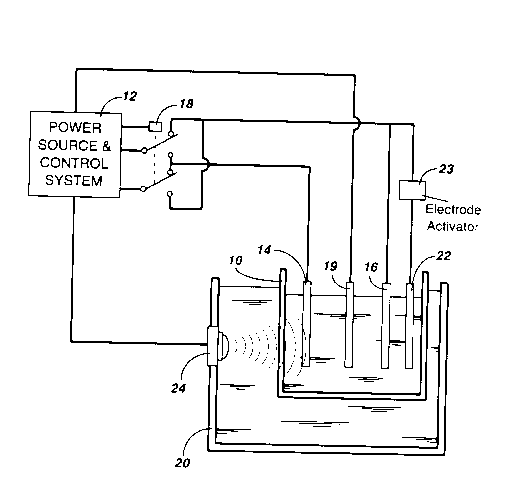Une partie des informations de ce site Web a été fournie par des sources externes. Le gouvernement du Canada n'assume aucune responsabilité concernant la précision, l'actualité ou la fiabilité des informations fournies par les sources externes. Les utilisateurs qui désirent employer cette information devraient consulter directement la source des informations. Le contenu fourni par les sources externes n'est pas assujetti aux exigences sur les langues officielles, la protection des renseignements personnels et l'accessibilité.
L'apparition de différences dans le texte et l'image des Revendications et de l'Abrégé dépend du moment auquel le document est publié. Les textes des Revendications et de l'Abrégé sont affichés :
| (12) Brevet: | (11) CA 2087801 |
|---|---|
| (54) Titre français: | METHODE PERMETTANT DE SURVEILLER EN LIGNE LA QUALITE D'UNE SOLUTION DE SULFATE METALLIQUE PURIFIEE, ET APPAREIL CONNEXE |
| (54) Titre anglais: | METHOD AND APPARATUS FOR ON-LINE MONITORING THE QUALITY OF A PURIFIED METAL SULPHATE SOLUTION |
| Statut: | Périmé et au-delà du délai pour l’annulation |
| (51) Classification internationale des brevets (CIB): |
|
|---|---|
| (72) Inventeurs : |
|
| (73) Titulaires : |
|
| (71) Demandeurs : |
|
| (74) Agent: | LAVERY, DE BILLY, LLP |
| (74) Co-agent: | |
| (45) Délivré: | 1996-08-13 |
| (22) Date de dépôt: | 1993-01-21 |
| (41) Mise à la disponibilité du public: | 1994-07-22 |
| Requête d'examen: | 1993-05-12 |
| Licence disponible: | S.O. |
| Cédé au domaine public: | S.O. |
| (25) Langue des documents déposés: | Anglais |
| Traité de coopération en matière de brevets (PCT): | Non |
|---|
| (30) Données de priorité de la demande: | S.O. |
|---|
A method and an apparatus for on-line monitoring
the quality of a purified metal sulphate solution is
disclosed. The method comprises the steps of depositing
metal from the purified metal sulphate solution onto a
working electrode submerged in the solution by passing
constant current through the solution at a current density
in the range of 25 to 150 mA/cm2 for a predetermined time
interval, dissolving the metal deposited on the working
electrode by reversing the polarity of the potential
applied between the working electrode and a counter
electrode so as to pass a reverse current of the same
current density through the solution until all zinc is
removed from the working electrode as sensed by a sudden
change in electrode potential, deriving the quality index
of the solution by calculating the ratio of the
dissolution time over the deposition time, and restoring
the surface of the counter electrode by effecting the
dissolution of the metal deposited on the counter
electrode at the end of each measurement.
Note : Les revendications sont présentées dans la langue officielle dans laquelle elles ont été soumises.
Note : Les descriptions sont présentées dans la langue officielle dans laquelle elles ont été soumises.

2024-08-01 : Dans le cadre de la transition vers les Brevets de nouvelle génération (BNG), la base de données sur les brevets canadiens (BDBC) contient désormais un Historique d'événement plus détaillé, qui reproduit le Journal des événements de notre nouvelle solution interne.
Veuillez noter que les événements débutant par « Inactive : » se réfèrent à des événements qui ne sont plus utilisés dans notre nouvelle solution interne.
Pour une meilleure compréhension de l'état de la demande ou brevet qui figure sur cette page, la rubrique Mise en garde , et les descriptions de Brevet , Historique d'événement , Taxes périodiques et Historique des paiements devraient être consultées.
| Description | Date |
|---|---|
| Inactive : CIB de MCD | 2006-03-11 |
| Le délai pour l'annulation est expiré | 2004-01-21 |
| Lettre envoyée | 2003-01-21 |
| Lettre envoyée | 2002-10-24 |
| Exigences relatives à la nomination d'un agent - jugée conforme | 2002-03-18 |
| Inactive : Lettre officielle | 2002-03-18 |
| Exigences relatives à la révocation de la nomination d'un agent - jugée conforme | 2002-03-18 |
| Demande visant la nomination d'un agent | 2002-02-01 |
| Inactive : TME en retard traitée | 2002-02-01 |
| Demande visant la révocation de la nomination d'un agent | 2002-02-01 |
| Inactive : TME en retard traitée | 2001-02-16 |
| Inactive : Lettre officielle | 2001-02-06 |
| Inactive : Lettre officielle | 2001-01-30 |
| Lettre envoyée | 2001-01-22 |
| Accordé par délivrance | 1996-08-13 |
| Demande publiée (accessible au public) | 1994-07-22 |
| Toutes les exigences pour l'examen - jugée conforme | 1993-05-12 |
| Exigences pour une requête d'examen - jugée conforme | 1993-05-12 |
Il n'y a pas d'historique d'abandonnement
| Type de taxes | Anniversaire | Échéance | Date payée |
|---|---|---|---|
| TM (brevet, 5e anniv.) - générale | 1998-01-21 | 1997-11-12 | |
| TM (brevet, 6e anniv.) - générale | 1999-01-21 | 1998-08-31 | |
| TM (brevet, 7e anniv.) - générale | 2000-01-21 | 1999-12-24 | |
| TM (brevet, 8e anniv.) - générale | 2001-01-22 | 2001-01-25 | |
| Annulation de la péremption réputée | 2002-01-21 | 2001-01-25 | |
| TM (brevet, 9e anniv.) - générale | 2002-01-21 | 2002-02-01 | |
| Annulation de la péremption réputée | 2002-01-21 | 2002-02-01 | |
| Enregistrement d'un document | 2002-09-19 |
Les titulaires actuels et antérieures au dossier sont affichés en ordre alphabétique.
| Titulaires actuels au dossier |
|---|
| NORANDA IPCO INC. |
| Titulaires antérieures au dossier |
|---|
| FRANK KITZINGER |
| GEORGE HOULACHI |
| GREGORY A. WINT |
| M. BARAKAT I. JANJUA |
| VLADIMIR M. LABUC |